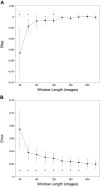Measuring short-term changes in specific ventilation using dynamic specific ventilation imaging
- PMID: 35482322
- PMCID: PMC9190736
- DOI: 10.1152/japplphysiol.00652.2021
Measuring short-term changes in specific ventilation using dynamic specific ventilation imaging
Abstract
Specific ventilation imaging (SVI) measures the spatial distribution of specific ventilation (SV) in the lung with MRI by using inhaled oxygen as a contrast agent. Because of the inherently low signal-to-noise ratio in the technique, multiple switches between inspiring air and O2 are utilized, and the high spatial resolution SV distribution is determined as an average over the entire imaging period (∼20 min). We hypothesized that a trade-off between spatial and temporal resolution could allow imaging at a higher temporal resolution, at the cost of a coarser, yet acceptable, spatial resolution. The appropriate window length and spatial resolution compromise were determined by generating synthetic data with signal- and contrast-to-noise characteristics reflective of that in previously published experimental data, with a known and unchanging distribution of SV, and showed that acceptable results could be obtained in an imaging period of ∼7 min (80 breaths), with a spatial resolution of ∼1 cm3. Previously published data were then reanalyzed. The average heterogeneity of the temporally resolved maps of SV was not different from the previous overall analysis, however, the temporally resolved maps were less effective at detecting the amount of bronchoconstriction resulting from methacholine administration. The results further indicated that the initial response to inhaled methacholine and subsequent inhalation of albuterol were largely complete within ∼22 min and ∼9 min, respectively, although there was a tendency for an ongoing developing effect in both cases. These results suggest that it is feasible to use a shortened SVI protocol, with a modest sacrifice in spatial resolution, to measure temporally dynamic processes.NEW & NOTEWORTHY Dynamic imaging providing maps of specific ventilation with a temporal resolution of ∼7 min with a spatial resolution of ∼1 cm3 using MRI was shown to be practical. The technique provides an ionizing radiation free means of temporally following the spatial pattern of specific ventilation. Reanalysis of previously published data showed that the effects of inhaled methacholine and albuterol were largely complete at ∼22 min and ∼9 min, respectively after administration.
Keywords: MRI; heterogeneity; time course; ventilation defects.
Conflict of interest statement
No conflicts of interest, financial or otherwise, are declared by the authors.
Figures





Similar articles
-
Regional airflow obstruction after bronchoconstriction and subsequent bronchodilation in subjects without pulmonary disease.J Appl Physiol (1985). 2019 Jul 1;127(1):31-39. doi: 10.1152/japplphysiol.00912.2018. Epub 2019 May 23. J Appl Physiol (1985). 2019. PMID: 31120808 Free PMC article.
-
Regional Ventilation and Aerosol Deposition with Helium-Oxygen in Bronchoconstricted Asthmatic Lungs.J Aerosol Med Pulm Drug Deliv. 2016 Jun;29(3):260-72. doi: 10.1089/jamp.2014.1204. Epub 2016 Jan 29. J Aerosol Med Pulm Drug Deliv. 2016. PMID: 26824777 Free PMC article.
-
Validating the distribution of specific ventilation in healthy humans measured using proton MR imaging.J Appl Physiol (1985). 2014 Apr 15;116(8):1048-56. doi: 10.1152/japplphysiol.00982.2013. Epub 2014 Feb 6. J Appl Physiol (1985). 2014. PMID: 24505099 Free PMC article.
-
Hyperpolarized helium-3 gas magnetic resonance imaging of the lung.Top Magn Reson Imaging. 2003 Jun;14(3):223-30. doi: 10.1097/00002142-200306000-00002. Top Magn Reson Imaging. 2003. PMID: 12973129 Review.
-
Elucidation of structure-function relationships in the lung: contributions from hyperpolarized 3helium MRI.Clin Physiol Funct Imaging. 2002 Nov;22(6):361-9. doi: 10.1046/j.1475-097x.2002.00444.x. Clin Physiol Funct Imaging. 2002. PMID: 12464138 Review.
References
Publication types
MeSH terms
Substances
Grants and funding
LinkOut - more resources
Full Text Sources

